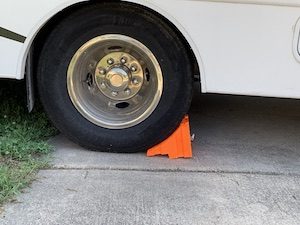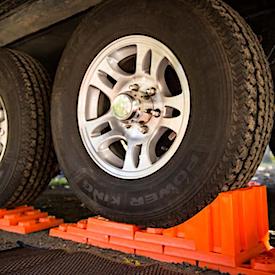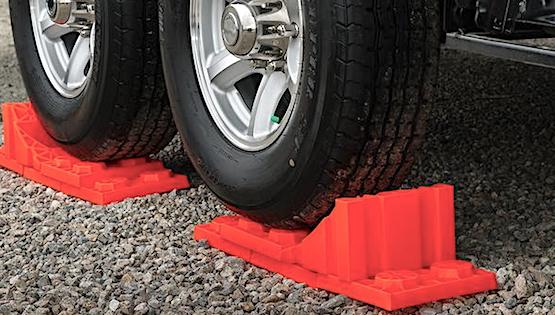Thanks for your support! If you make a purchase using our links in this article, we may make a commission. And, as an Amazon Associate, I earn from qualifying purchases. See the full disclosure here.
Wheel chocks are necessary for your RV or travel trailer to keep them from rolling away. Parking brakes work well to keep your rig stable, but they are not reliable on their own. Instead, they are much less likely to fail when used in combination with chocks.
RV wheel chocks are sturdy wedges that fit right under your tires. They come in many materials, sizes, and shapes, giving buyers many options.
While there are dozens to choose from, they all serve one essential purpose – to prevent damage or injury. Read on to learn about wheel chocks and how to use them, so you can decide which type works best for you.
Do I Need RV Wheel Chocks for my Camper?
Whether you are at a campground or in your driveway, always use wheel chocks for your RV. They are reasonably priced and easy to use, making them a preferable choice.
Using RV wheel chocks is beneficial for a few reasons. First, they keep the vehicle from slipping. Second, they prevent excess movement while walking inside the cabin.
Although you should always use wheel chocks when parked, they are especially important when on uneven, or steep surfaces. Use wheel chocks in combination with air brakes, as they work best together.
Remember that it only takes one quick moment for your RV to lose its grip and cause an accident. Taking as many safety precautions as possible will prevent these tragedies from occurring.
Wheel chocks also help to secure the RV while you are parked. Excess motion causes frustration when you have to tie things down all the time. Chocks help solve this issue by locking the body in place. Note that they will not stop it from swaying side to side but they will limit most of the back and forth movement.
While using wheel chocks when you have a parking brake may seem silly, they will make your stay much more safe and secure. Taking a few extra moments to put them in will pay off in the long run.
Do I Need Wheel Chocks for My Camper Trailer or 5th Wheel?
Chocking your camper trailer or 5th wheel is especially important since there is no parking brake to keep them from rolling.
Even when attached to a vehicle, use chocks whenever the unit is parked. The emergency brake on a car or truck is not strong enough to keep your rig from detaching and heading downhill. To avoid losing both your camper and vehicle take these simple preventative measures.
Like an RV, wheel chocks will stabilize your trailer and prevent excess movement while you’re inside. Uneven gravel and steep terrains will make this issue much worse; therefore, only parking on smooth, flat ground will help a lot.
Although campgrounds try to give campers a level campsite, you should always plan for unlevel conditions. If you must park on a slope or a rough terrain, you want to be positive your chocks are reliable. Even when you have properly secured your chocks, stay extra cautious, and take necessary measures to guarantee safety.
Spending a few extra dollars before is much better than owing thousands of dollars in damages later. Purchase heavy duty wheel chocks for your travel trailer or 5th wheel as soon as possible to avoid severe consequences.
How Do You Use RV Wheel Chocks?
To learn how you use RV wheel chocks, you must understand their purpose. These small ramps oppose the force against your tires to keep it steady. For instance, if you are on an incline, the chock will prevent gravity from moving the wheels downward. In turn, the trailer cannot move, giving it stability.

Try your hardest to park on only pavement and concrete since these surfaces have the most friction for the chocks. And, if possible, park on the flattest areas to reduce the pressure against the tires.
Loose dirt or gravel, on the other hand, makes for a tricky situation. Both the chocks and RV or trailer are much more likely to skid on these terrains. Wet or icy conditions will also pose a threat since the unit can slip or slide. Keep your camper in wind-protected areas, such as those surrounded by trees or buildings. Strong wind gusts can cause excess sway and may throw the RV off balance.
Installing your wheel chocks is relatively simple whether you are camping or storing your RV. First, park in a secure location and put on the emergency brake. Then, securely place the chocks to the tire against the incline. For example, if your front end is slanting downward, then place them in front of the tires. Conversely, if the back end is on a slope, put them behind the wheels. Be sure to place chocks in the center of the rubber, as putting them on the sides will lessen their ability to lock the RV into place.
For travel trailers or fifth wheels, follow a similar procedure. Move your vehicle into the desired area, put it into park, and turn on the emergency brake. Next, install the chocks using the process stated above. You may detach your vehicle and drive away once you complete this step.
How Many Wheel Chocks are Required for an RV or Travel Trailer?
Weight and incline grade determine how many wheel chocks you need for your RV. Smaller RVs may only need one or two. But larger motorhomes may actually require four. Refer to your owner’s manual for specifics, as it should give you more insight.
Nonetheless, heavier vehicles need more support. RVs and heavy trailers fall into this category. Therefore, you should use one chock per tire to make sure it does not roll away. Using four chocks also secures both the front and back end to limit movement.
For smaller trailers or fifth wheels, you may be able to get away with two chocks. However, you should read the guidelines from your owner’s manual for more information. If you only use two chocks, be confident that they are sturdy and secure.
Always make sure the wheel chock is snug against the tire to reduce the chance for slipping or sliding. Remember that using more chocks correlates with better safety.
Types of Wheel Chocks
Choosing the right type of wheel chock for your RV is crucial. For example, the wheel may roll over a chock that is too small. Likewise, a low-quality, plastic chock can easily break from the weight of the rig. To prevent these dangerous situations, purchase only the best chocks for your unit.
Do not be fooled into buying plastic chocks. Although typically cheaper, they are also more likely to fail due to wear and breakage. Spending a little more here goes a long way, as sturdier RV chocks will both work better and last longer.
Only purchase chocks that are specific to your motorhome or trailer to guarantee protection. Furthermore, choosing durable materials like aluminum and rubber makes them more dependable.
Aluminum does not rust and will not wear over time. These chocks will not break or bend, no matter the weather. They also usually have metal teeth on the bottom to better grip the ground and further secure your RV.
Rubber and synthetic is also a great alternative with its resistance to damage from weather and erosion. Synthetic material resists corrosion from oils and chemicals, as well. They are well worth the cost, as they last longer than any other type of chock.
Chock shape is another factor to consider. Some chocks are curved and fit to the exact shape of the tire. Others have a pyramid design with a bottom lip and act as a wedge between the wheel and the ground.
The weight of your RV and tire size will determine the right chocks for you. To get an idea of the dimensions, first, measure the height of your tire. Divide this number by four, and select your chocks based upon this size. Packaging will specify which vehicles they accommodate, so abide by these details when purchasing.
What About X Chocks?

X Chocks are used between the tires of an RV with two sets of tires. The X-chock fits between the tires and then it is tightened so it expands and creates pressure against the tires. However, the manufacturers of x chocks say not to use them as wheel chocks for your trailer which means they will not prevent your trailer from moving down a slope. They are really just meant to limit the movement of the trailer or 5th wheel while you are walking around inside.
However, some people say they have used them with no other chocks without having any problems. I’m guessing they probably park on the most level surface they could find. To me, it’s just not worth the risk. I think wheel chocks are the safest way to go.
It only takes the one time for the x chocks to slip and your camper trailer to roll and cause damage or worse yet, hurt someone.
DIY RV Wheel Chocks
Homemade wheel chocks are a temporary solution when you are in a pinch. They should never be a permanent solution, however. Only those who have experience with DIY RV wheel chocks should make their own to prevent damage or injury.
Furthermore, many RVers who use wooden blocks are unaware of the dangers of using them. Unlike other sturdy materials, wood wears away after time. Water and heat damage are especially corrosive, which may result in breakage and bending. And if the wood snaps, there is a high chance your RV will lose its balance.
Despite this risk, some still prefer DIY RV wheel chocks. If you must make your own, then follow these simple guidelines to make them as safe and sturdy as possible.
For standard 15-inch tires, use a 4×4 treated wood piece that is approximately 12 inches long. Typically, a 45-degree wedge angle will suffice, but for an exact measurement use your tire angle as a reference. Mark the wood, then use a handsaw or electric saw to cut along this line.
To help you better pull the wheel chocks out, attaching rope may be helpful. You can do this by screwing a metal loop into the wood and weaving rope through it. Or you can staple the rope and loop it around the chock.
Now, place your homemade chocks under your tires and you’re ready to go!
RELATED READING: For all sorts of questions asked most often about Travel Trailers check out our article called 10 Most Googled Travel Trailer Camping Questions.
Can I Use Leveling Blocks and Wheel Chocks at the Same Time?
Using leveling blocks improves your camping experience by leveling out your RV or travel trailer. For example, you might find yourself in a position where it’s difficult to keep your balance when walking in your RV. This situation will get old quickly and leave you very frustrated.
An unlevel RV or trailer is annoying, but also damaging. Uneven grounds will cause your absorption refrigerator to sit at an angle. If this occurs, the liquid inside the fridge will not reach the area needed to cool it down. In this case, your food may spoil, or the unit may break from overheating.
To fix this issue, use leveling blocks in tandem with wheel chocks. Together, they will level the unit and prevent it from rolling away. Some sites or parking lots appear level even though they are not. Therefore, you should always use both leveling blocks and wheel chocks when parking to promote safety.

Leveling blocks are easy to use and require very few tools depending on the kind you purchase. Again, always use store brand blocks rather than making them yourself to guarantee their safety and ability.
We use Tri-Lynx Leveling blocks and Tri-Lynx wheel chocks for our RV. They are made to fit together so we can very easily level and chock our RV in place. Plus they are bright orange so there is less chance we will forget them when we break camp and drive away. You can either click the links here in the article or check them out on our Gear Page for more info but we think they are great products and highly recommend that you use them too.
RELATED READING: If you are new to Travel Trailer Camping maybe consider renting one before you buy one. Check out our article Travel Trailer Rental Prices – Find Your Best Deal to find the perfect rental for you.
Conclusion
Letting your rig slip away can cause irreplaceable damage or injury. RV wheel chocks ensure safety for both you and those around you. Spending an extra few minutes to put in and take out your chocks is more than worthwhile. They are both cheap and easy-to-use, making them a simple solution to a potentially catastrophic situation.
Do you use wheel chocks? Or do you use x chocks with or without regular wheel chocks? Please leave a comment below.
For more information check out our helpful articles below:
- How To Level a Travel Trailer on a Slope
- Do I Need a Battery for My Travel Trailer?
- Can I Dump RV Tanks at Home?
- 10 Best-Built Fifth Wheels You Need to Know About
- The Best SUV for a Towable Travel Trailer
- Do Dryer Sheets Keep Mice Away From RVs and Campers?
- Travel Trailer Depreciation: What’s My Travel Trailer Worth?
- Travel Trailer Turning Radius Tips
- Can I Legally Ride In A Travel Trailer?



Great and practical tips you have shared here! I really appreciate your research. Hope to read more articles on your blog…!!! Keep it up.
Thanks for the great tips!
Thanks Bailey…I’m glad you liked the article!
Mike